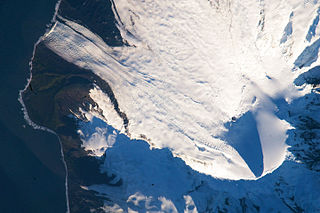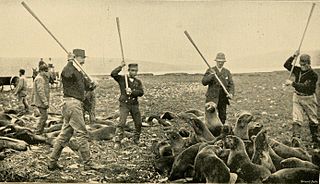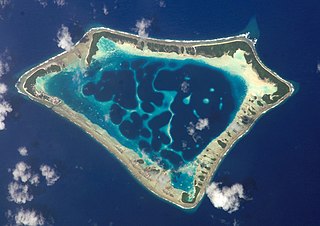
Jacka Glacier is a 0.8-mile (1.3 km) long glacier which flows northeast from Hayter Peak and terminates in icefalls opposite Vanhoffen Bluff on the north side of Heard Island in the southern Indian Ocean. The glacier appears to be roughly charted on an 1860 sketch map compiled by Captain H.C. Chester, an American sealer operating in the area during this period. It was surveyed in 1948 by the Australian National Antarctic Research Expeditions, and named by them for Fred J. Jacka, an expedition physicist.
Atlas Cove is a cove on the north coast of Heard Island in the southern Indian Ocean, and is entered between the base of the Laurens Peninsula and Rogers Head.
Gilchrist Aiguilles is a series of sharp peaks close south of Mount Olsen on Laurens Peninsula, Heard Island.

Brown Glacier is a glacier just south of Round Hill on the east side of Heard Island in the southern Indian Ocean. Its terminus is at Brown Lagoon. To the northwest of Brown Glacier is Compton Glacier, whose terminus is located at Compton Lagoon, between Gilchrist Beach and Fairchild Beach. To the southeast of Brown Glacier is Stephenson Glacier, whose terminus is located between Dovers Moraine and Stephenson Lagoon.

Cape Arkona is a rocky headland between the mouths of Lied Glacier and Gotley Glacier on the southwest side of Heard Island in the southern Indian Ocean. The feature appears to be roughly charted on an 1860 sketch map prepared by Captain H.C. Chester, an American sealer operating in the area during this period. The German frigate Arkona examined the south coast of the island in February 1874 and, in Melbourne, provided the officers of HMS Challenger with a position for the cape which was used in preparation of the Admiralty chart. In so doing, however, the misspelling "Cape Arcona" was used on the British chart.
Fairchild Beach is a sandy beach, 0.3 nautical miles (0.6 km) wide and 1 nautical mile (2 km) long, which extends north from the base of Round Hill to the south side of the terminus of Compton Glacier, on the east side of Heard Island in the southern Indian Ocean. The beach faces Compton Lagoon, and at its western edge communicates with the rocky Gilchrist Beach. To the south of Fairchild Beach is Brown Glacier, whose terminus is located at Brown Lagoon.
Round Hill is an ice-free, rounded hill rising southward of Fairchild Beach and between Compton Glacier and Brown Glacier, on the northeast side of Heard Island. Travelling westwards from the sandy Fairchild Beach at the base of Round Hill, one arrives at the rocky Gilchrist Beach.

Ealey Glacier is a glacier, flowing northeast from the lower slopes of the Big Ben massif to the northeast side of Heard Island in the southern Indian Ocean. Its terminus is located close southeast of Cape Bidlingmaier, between Melbourne Bluff and North Barrier. The glacier terminates in ice cliffs. To the southeast of Ealey Glacier is Compton Glacier, whose terminus is located at Compton Lagoon, between Gilchrist Beach and Fairchild Beach. To the west of Ealey Glacier is Downes Glacier, whose terminus is located at Mechanics Bay, between Saddle Point and Cape Bidlingmaier.
Cape Gazert is a cape at the western end of the rocky promontory which forms the south side of South West Bay, on the west side of Heard Island in the southern Indian Ocean. This feature was known to American sealers as "Green Point", as shown by Captain H.C. Chester's 1860 sketch map and other sealer maps of the period. The present name was applied by the First German Antarctica Expedition when they landed at the feature in February 1902, after Doctor Hans Gazert, medical officer with the expedition, and it has become established in international usage.
South West Bay is an open bay indenting the west side of Heard Island immediately north of Cape Gazert in the southern Indian Ocean. The bay was roughly charted on an 1860 sketch map compiled by Captain H.C. Chester, an American sealer. The name "S.W. Bay" appears on an 1882 chart compiled by Ens. Washington Irving Chambers aboard the USS Marion at Heard Island in January 1882. The bay name appears to have developed from an American sealer name, "Southwest Beach," in use about 1860 for the pebble beach at the north end of this bay.
Winston Lagoon is a lagoon indenting the southeast coast of Heard Island in the southern Indian Ocean, about 1 nautical mile (1.9 km) northeast of Cape Lockyer. The feature is roughly portrayed on an American sealer chart of the 1860 period. It was sighted from the air by Lieutenant Malcolm Smith, RAAF, pilot of the ANARE seaplane that made the first reconnaissance flight over the island in 1948. Lieutenant Smith proposed that it be named Lake Winston after his wife. In view of his death in an aircraft accident shortly afterward, this proposal was adopted by Australian Antarctic Names and Medals Committee (ANCA) with only a change of generic term. Click here to see a map of Heard Island and McDonald Islands, including all major topographical features.
Cape Bidlingmaier is a rocky cape at the east side of the entrance to Mechanics Bay, on the north side of Heard Island in the southern Indian Ocean. The feature appears to have been known to American sealers as Morgan's Point, as shown by Captain H.C. Chester's 1860 sketch map of the island. The name Negros Head was also in use by American sealers during the 1860–70 period. The name Bidlingmaier was applied by the First German Antarctica Expedition, under Erich von Drygalski, who made a running survey and landing along the north side of the island in 1902. Friedrich Bidlingmaier served as magnetician and meteorologist with the expedition.
Budd Peak is a peak, 2,315 metres (7,600 ft) high, 1.7 nautical miles (3.1 km) southeast of Mawson Peak on Heard Island. The peak was mapped by Australian National Antarctic Research Expeditions (ANARE) in 1948, and named by the Antarctic Names Committee of Australia for G.M. Budd, ANARE officer-in-charge on Heard Island in 1954, and leader of the 1963 ANARE Heard Island expedition.
Cave Bay is a cove, 0.3 nautical miles (0.6 km) wide, which has been formed by the erosion of an extinct volcanic crater of which Mount Andree forms the north side, indenting the west side of Heard Island between West Bay and South West Bay. The cove is roughly charted on an American sealer's sketch map prepared during the 1860–70 period. It was more accurately charted and first named on a geological sketch map illustrating the 1929 work of the British Australian New Zealand Antarctic Research Expedition under Douglas Mawson.
Mount Olsen is a snow-covered peak standing 0.2 nautical miles (0.4 km) east of Hayter Peak on Laurens Peninsula, in the northwest part of Heard Island.
Mount Dixon is a snow-covered peak, 705 metres (2,310 ft) high, standing 0.7 nautical miles (1.3 km) west of Anzac Peak on the Laurens Peninsula, Heard Island. The feature appears to have been roughly charted on an 1860 sketch map by Captain H.C. Chester, an American sealer operating in the area during this period. It was surveyed in 1948 by the Australian National Antarctic Research Expeditions (ANARE), and named by them for Lieutenant Commander George M. Dixon, RANVR, commanding officer of HMAS Labuan which landed and relieved the 1948 and 1949 ANARE parties.
Mount Separation is a rocky peak, 1,480 m, standing 1 nautical mile (1.9 km) northeast of Campbell Peak on the northeast flank of Big Ben, the dominating mountain on Heard Island. Surveyed in 1948 by the ANARE and probably so named by them because this feature lies somewhat apart from the main cluster of peaks near the summit of Big Ben.
Skua Beach is a sandy beach lying at the base of Scarlet Hill on the east side of Heard Island. The name "Launches Beach" appears to have had some usage by American sealers as shown by an unpublished sealer's map of "Hurds Island" of the 1860-70 period. The name Skua Beach was given by ANARE during its 1948 survey of the island and is now established in usage.
Vanhoffen Bluff is a rocky bluff immediately east of Jacka Glacier on the north coast of Heard Island. It is named for Ernst Vanhöffen (1858–1918), a German zoologist, and a member of the Gauss expedition under the leadership of Erich von Drygalski (1865–1949). During its 1902 investigations of the area, Drygalski applied the name Kap Vanhoffen to a cliffed feature about 1.5 nautical miles (2.8 km) to the northwest, near The Sentinel. The ANARE, during its 1948 survey of the island, transferred the Vanhoffen name to this bluff, reporting that no well-marked cape exists along the high cliffs to the northwest.
Lambeth Bluff is a rock coastal bluff at the east side of Fiftyone Glacier, on the south side of Heard Island. It was surveyed in 1948 by the Australian National Antarctic Research Expeditions (ANARE) and named "Cape Lambeth" for A. James Lambeth, a geologist with the expedition. Further ANARE exploration led to revision of the name in 1964 to Lambeth Bluff.




